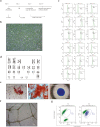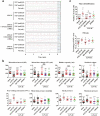Safety of Human Embryonic Stem Cell-derived Mesenchymal Stem Cells for Treating Interstitial Cystitis: A Phase I Study
- PMID: 36069837
- PMCID: PMC9585946
- DOI: 10.1093/stcltm/szac065
Safety of Human Embryonic Stem Cell-derived Mesenchymal Stem Cells for Treating Interstitial Cystitis: A Phase I Study
Abstract
There are still no definite treatment modalities for interstitial cystitis (IC). Meanwhile, stem cell therapy is rising as potential alternative for various chronic diseases. This study aimed to investigate the safety of the clinical-grade mesenchymal stem cells (MSCs) derived from human embryonic stem cells (hESCs), code name MR-MC-01 (SNU42-MMSCs), in IC patients. Three female IC patients with (1) symptom duration >6 months, (2) visual pain analog scale (VAS) ≥4, and (3) one or two Hunner lesions <2 cm in-office cystoscopy within 1 month were included. Under general anesthesia, participants received cystoscopic submucosal injection of SNU42-MMSCs (2.0 × 107/5 mL) at the center or margin of Hunner lesions and other parts of the bladder wall except trigone with each injection volume of 1 mL. Follow-up was 1, 3, 6, 9, and 12 months postoperatively. Patients underwent scheduled follow-ups, and symptoms were evaluated with validated questionnaires at each visit. No SNU42-MMSCs-related adverse events including immune reaction and abnormalities on laboratory tests and image examinations were reported up to 12-month follow-up. VAS pain was temporarily improved in all subjects. No de novo Hunner lesions were observed and one lesion of the first subject was not identifiable on 12-month cystoscopy. This study reports the first clinical application of transurethral hESC-derived MSC injection in three patients with IC. hESC-based therapeutics was safe and proved to have potential therapeutic efficacy in IC patients. Stem cell therapy could be a potential therapeutic option for treating IC.
Keywords: Hunner lesion; clinical trial; embryonic stem cell; interstitial cystitis; mesenchymal stem cell.
© The Author(s) 2022. Published by Oxford University Press.
Figures




References
Publication types
MeSH terms
LinkOut - more resources
Full Text Sources
Medical
Miscellaneous

